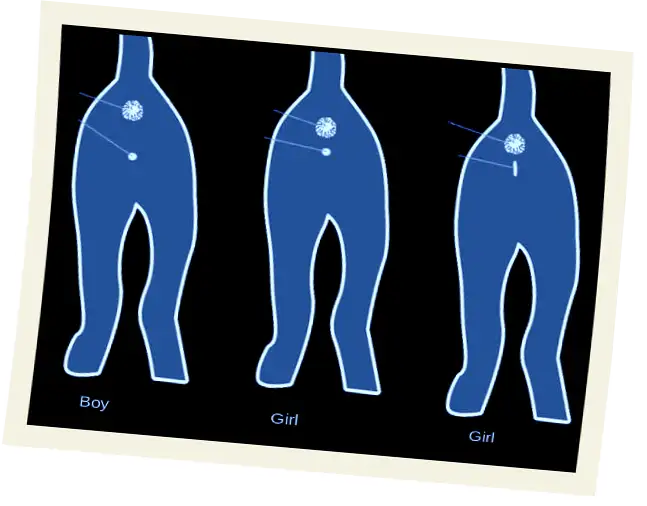Determine the sex of a kitten at 2-3 months can be determined by the peculiarities of the structure of the reproductive organs. To do this with newborn babies is more difficult. Sometimes owners even turn to a veterinarian with this question. It is also possible to identify the sex yourself at home by the shape of the genitals, behavior, coloring, etc.
The main sign: in boys the anus and genitals are far apart, in girls close, almost merging.
Why do you need to determine the sex
To know the sex of a kitten is necessary for the following reasons:
- The pet should be given a nickname. It is undesirable to change it at an advanced age, since the cat or cat already knows its name and responds to it.
- It is necessary to determine in advance whether the pet will need to be spayed or neutered in the future.
- The animal has its own characteristics of behavior depending on the sex. Owners should select a pet based on this fact. For example, cats are more likely to mark the territory, because of this there is an unpleasant smell in the apartment. Unsterilized females periodically have heat. Their behavior changes, they begin to demand a cat. When giving birth to babies, the cat becomes aggressive.
Rules of communication with kittens when determining the sex
Kittens must be treated with care so as not to cause harm. Before determining the sex, there are some nuances to consider:
- A kitten should not be taken away from its mother for a long time. Its fur may absorb human scent, and then the cat will not take the cub back.
- Before you take the pet in your arms, you should wash them thoroughly without soap or with a fragrance-free sanitizer.
- A kitten’s body is not yet strong enough and it must be handled with care so as not to damage its bones or internal organs.
- Do not pull or tug its tail.
- It is not recommended to take the kitten in your hands when he is suckling milk.
- If the mother does not like her cub to be touched, it is advisable to postpone the examination until she is not around.
Appropriate age for detecting sex
- It is easier to visually determine the sex of small kittens when they are less than seven days old. They have not yet had time to fluff up and the organs are clearly visible. This is especially true for long-haired pedigree animals with thick undercoat. For example, a lop-eared Scottie.
- At the age of a week it is easy to make a mistake with the sex. However, it is even harder to decide on the affiliation at two or three weeks of age. The kitten is completely covered with fur, which will cover the view of the genitals. This does not apply to hairless breeds. For example, a sphynx.
- At two or three months, it is already easier to determine the sex. The genitalia are fully formed and well visible. Females and males can be unmistakably distinguished at six months of age, even in long-haired breeds (such as the British). At this age, puberty begins: reproductive organs are clearly visible, cats mark their territory, and cats start to heat.
Basic methods for determining sex

Most often the sex is determined by the genitalia. However, they are poorly formed at an early age and even an experienced veterinarian does not always succeed. Therefore, other methods of determining sex have been invented.
By behavior

At the age of a few weeks, the sex is determined by the manner of behavior:
- Males are more active than cats.
- Males try to take a dominant position, leading in games.
- The fight for the mother’s teats when feeding is won by the boys. This later extends to the best pieces of food.
- The signs listed only confirm the sex, but do not prove it. It is possible to accurately determine sex by 3 to 4 months of the pet’s life. In males, the scrotum is clearly visible, which is absent in females.
By the shape of the genitals
To determine the sex of a kitten, you need to look under its tail. The genitalia of a girl are close to the anus (the distance is not more than one centimeter). Externally, they have the appearance of a thin vertical stripe. In males they look like two round dots. They are located at a distance of two to three centimeters from the anus. Closer to three months of age, the cat will have testicles which allow the sex to be determined instantly.
By coloration
If you can’t tell the sex from the genitals, you can do it from the coat. Turtle color (combination of three shades) indicates that the kitten is a girl. This is due to the genetic code. Black and red coloring is only found in the X chromosomes. Cats always have two of them. Males are rarely tricolored. If they do, they are sterile because they only have one X chromosome. Cats are more likely to be red-haired than females.
By palpation
The easiest way to determine sex is by palpation. It is recommended to do this when the pet is at least two months old. At an earlier age, their future location can be determined by the density and color of the coat. It is different from other areas. When groping, you need to be as careful as possible so as not to damage the organs. The genitals are gently swiped with a finger. If the animal is male, his testicles are palpated.
The method of palpation is not accurate. The testicles do not always descend from the peritoneum by three months of age. Newborn females may have changes in the hormonal background. Because of this, there is swelling under the tail and it is possible to make an error in determining sex.
By body structure

By about six months of age, the sex of the pet is determined by external signs. Cats have a graceful body, thin, elongated muzzle. Males have a large head. The body is stocky and muscular. There are exceptions, but rarely.
Behaviorally
The male at about seven months of age may begin to mark territory. In females, by six months begins to heat. During this period, she is constantly petting, arching her back, lifting her butt up.
Cats sleep most of the time. Females try to show independence and may even be aggressive towards people, they are cleaner, wash constantly and usually go to the toilet only in the litter box.
DNA test
An unambiguous determination of a kitten’s sex can be made with a DNA test. This is done at veterinary clinics. The sex can be determined this way even in the first days of life. However, the procedure is expensive. It is usually resorted to by owners of pedigree cats (Scottish, Angora, etc.).
Visual distinctions of a male kitten
Visually, a male cat is recognized by the following signs:
- A large distance between the anus and reproductive organs (1-2 centimeters);
- genitalia in the shape of two dots;
- the lumen of the rectum and the genitals resemble a colon sign;
- wool grows between the orifices;
- testicles are prominent;
- Cats grow and gain body weight faster;
- Massive build, broad chest, large paws.
- Examination of external signs is performed on a hard and flat surface covered with a soft towel. The kitten is placed on its stomach and its tail is gently raised to determine its sex.
External distinguishing features of a female kitten
The external distinguishing features of a cat:
- The anus and childbearing organs are almost touching;
- The genitalia resemble a line, with the anus forming an “i”;
- no fur grows between the anus and genitals;
- refined, graceful shape of body and muzzle.
If there are several kittens in a litter, you can compare their genitalia. When the cubs are of different sexes, the differences in the reproductive organs can be seen immediately.
Other ways of determining the sex of a kitten

You can put a saucer with milk in front of the kitten and observe his behavior. It is believed that if the pet raises its tail up, it is a male, and if it is lowered down, it is a cat.
You can distinguish between girls and boys in a litter in the following unconventional ways:
- Cats have a more pronounced urine scent;
- boys are less playful and more affectionate;
- cats have smaller skulls and gentler muzzles (this is not an exact way to determine the sex, the structure of the head depends on the individual peculiarities of an animal);
- cats have a calm and self-assured look; cats have a wary look in their eyes.





